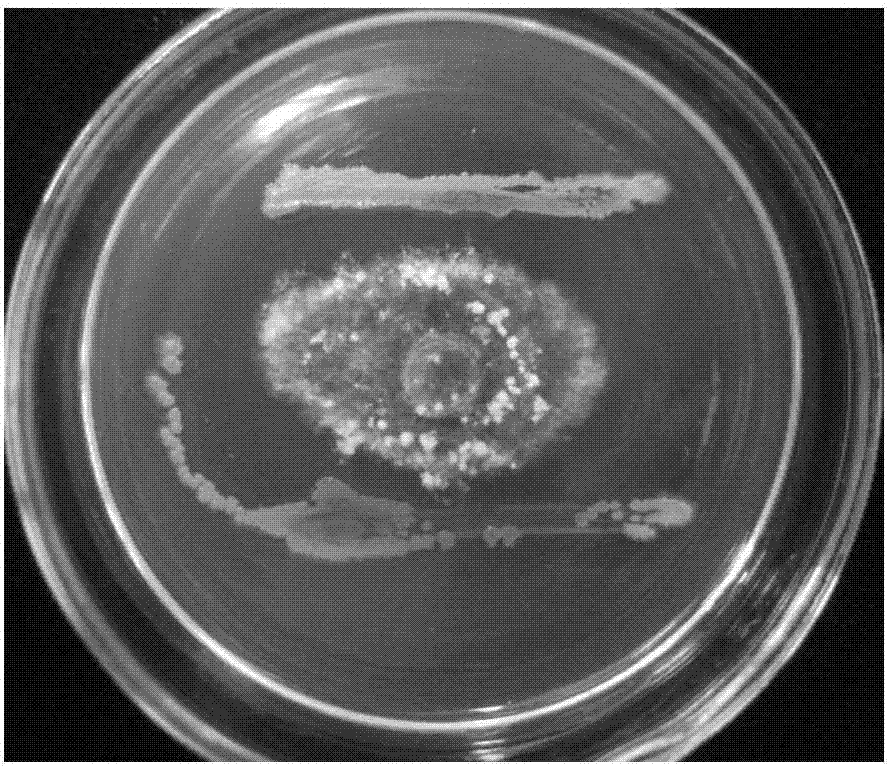Brevibacillus laterosporus for inhibiting riziocotinia solani, and application thereof
A technology of rice sheath blight and Brevibacterium, which is applied in the field of microbial control of rice sheath blight, and can solve the problem that there is no B. Dosage, etc.
- Summary
- Abstract
- Description
- Claims
- Application Information
AI Technical Summary
Problems solved by technology
Method used
Image
Examples
Embodiment 1
[0026] Example 1: Screening, isolation and identification of strains
[0027] Isolation and cultivation of bacterial strains: the medium is beef extract-peptone agar medium (NA): 3g of beef extract, 5g of peptone, 5g of sodium chloride, 20g of agar, 1000ml of distilled water, pH 7.0-7.2.
[0028] Separation by dilution coating method. Weigh 10g of newly collected soil (or the soil after drying in the shade), pour it into a triangular flask filled with 90ml of sterile water, shake it for 10min to form a suspension with a concentration of 1 / 10, bathe in 80°C water for 20min, and take 1ml of the supernatant solution, prepared as 10 -7 or 10 -8Concentration dilutions are available for use. Pour the melted NA into a sterilized petri dish. After solidification, draw 50 μl of the diluent and drop it on the surface of the solidified medium, spread it evenly with a sterile applicator stick, and place the petri dish upside down in a 28°C incubator for cultivation 1~2d. After the gr...
Embodiment 2
[0030] Example 2: Determination of the inhibitory effect of bacterial strain SNB10 on rice sheath blight pathogen by confrontation culture
[0031] Take a dish of rice sheath blight bacteria with a diameter of 8 mm and put it in the center of a petri dish filled with PDA. At a distance of 2 cm from the dish, use an inoculation ring stained with strain SNB10 to draw two parallel straight lines, and incubate at 28 ° C for 3 days , measure the width of the inhibition zone, and observe the growth of rice sheath blight mycelia in the inhibition zone by microscopic observation ( figure 2 ); continue to cultivate for 30 days until the rice sheath blight fungus produces sclerotia, and observe the persistence of the inhibitory effect. The test results showed that the strain SNB10 could strongly inhibit the growth of the rice sheath blight fungus, and microscopic observations showed that the hyphae of the rice sheath blight fungus were deformed and broken, the cell membrane changed, th...
Embodiment 3
[0032] Embodiment 3: the mensuration of antibacterial activity of bacterial strain SNB10 fermented liquid
[0033] Preparation of sterile fermentation filtrate: Transfer the strain SNB10 to fresh slant medium, culture it at 28°C for 1 day, inoculate it into a 250ml Erlenmeyer flask with a liquid volume of 50ml, rotate it at 28°C with a speed of 150r / min Vibrated on a shaker for 40 hours to obtain a fermentation stock solution, which was centrifuged at 10,000 r / min for 20 minutes and placed in a Filtrated in a bacterial filter to obtain a sterile fermentation filtrate to determine its antibacterial activity.
[0034] Fermentation medium: 3g beef extract, 5g peptone, 5g sodium chloride, 1000ml distilled water, pH 7.0-7.2.
[0035] The antibacterial activity of strain SNB10 aseptic fermentation filtrate on rice sheath blight was determined by the cup-and-disc method: the rice sheath blight bacteria dish with a diameter of 8 mm was placed upside down in the center of the PDA pla...
PUM
| Property | Measurement | Unit |
|---|---|---|
| diameter | aaaaa | aaaaa |
Abstract
Description
Claims
Application Information
 Login to View More
Login to View More - Generate Ideas
- Intellectual Property
- Life Sciences
- Materials
- Tech Scout
- Unparalleled Data Quality
- Higher Quality Content
- 60% Fewer Hallucinations
Browse by: Latest US Patents, China's latest patents, Technical Efficacy Thesaurus, Application Domain, Technology Topic, Popular Technical Reports.
© 2025 PatSnap. All rights reserved.Legal|Privacy policy|Modern Slavery Act Transparency Statement|Sitemap|About US| Contact US: help@patsnap.com



